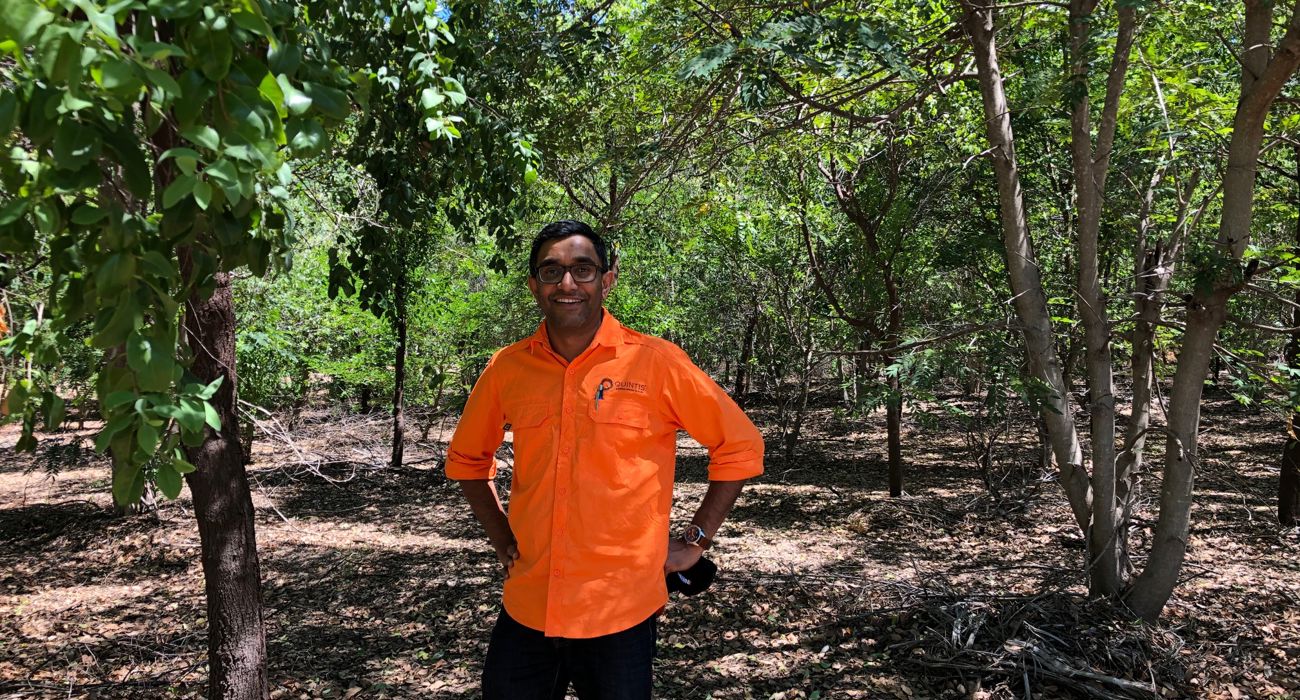It’s 40 degrees Celsius, the sun is high and bright, dipping in an out of the foamy clouds. There is a soothing breeze which cascades through the rows and rows of sandalwood trees, briefly skimming past everyone standing on the edge of the plantation.
“You’re transported elsewhere”, says Danny Hettiarachchi, Quintis’ Product Manager. The woody essence of Indian sandalwood wafts over him as he begins his day in one of our far-north sandalwood plantations in Kununurra, Western Australia. “As soon as you smell the fragrance of Indian sandalwood it’s like walking into a moment in time, a memory from the past”.
With over 13 years of experience in all things sandalwood, Danny knows how significant these sandalwood plantations are. “Sandalwood has been revered for so long, with a history far greater than many people realise. The fact that over poaching in the wild has diminished the stocks of this wonderful tree is saddening, but Quintis is doing something truly special for the species”.
Danny serves as the expert witness on sandalwood for the State of Western Australia, making his expertise in the difference between wild-grown and plantation sandalwood significant. As Western Australia plays host to the native Santalum spicatum (Australian sandalwood), many didn’t realise the potential for Australian soil to host S.spicatum’s regal cousin (Indian sandalwood known as Santalum album) until Quintis pioneered this concept over 20 years ago.
"As soon as you smell the fragrance of Indian sandalwood it’s like walking into a moment in time, a memory from the past"
Danny Hettiarachchi
“There are so many benefits to plantation grown Indian sandalwood” Danny says. “The significant difference is our ability to research, document and continuously improve the growing conditions and outcomes for the trees”. Quintis has dedicated the last two decades to understanding this complex species which has proven significant in our ability to supply high-quality Indian sandalwood products.
From drip-irrigation systems, sap-flow meters, bespoke machinery, imaging technology and custom-built testing facilities, there is more to the Quintis business than meets the eye. “The scale of our operations is impressive, but the most obvious difference is the care provided from planting through to the eventual harvest of these trees. You don’t get that in the wild”, says Danny. “Wild Australian sandalwood is unlike wild-grown Indian sandalwood because it’s regulated by the Forest Products Commission, so a level of care can be assumed. However, in other parts of the world, the industry has been rife with black and grey market sales of illegally poached trees”.
Quintis has developed a traceable process where each product supplied is able to be traced back to the trees which make up the oil, powder, chips or logs in each batch supplied. “At the core of the differences is our ability to offer a fully traceable product. In the wild, you just can’t do that” says Danny. Ensuring a transparent and trackable process was imperative to Quintis’ expert teams who have dedicated their careers to growing over five million trees across the company’s sandalwood plantations.
“The people at Quintis? They’re meticulous. Their expertise is second to none. Our people work with the trees, out in the field day-to-day. It’s really special to be able to be here, continue to learn and understand from their perspective, as well as see the incredible progress that has been made to-date”.
What was once a flood plain, Danny wanders through rows of Indian sandalwood trees and host plants. By planting trees in this land exhausted by annular crops, Quintis was able to create an ecosystem for flora and fauna to thrive. “I can’t even begin to tell you how many different insects I’ve seen, and the birds? They’re plentiful.” Quintis’ plantations have become home to over 100 bird species which otherwise find difficult to nest in this particular area.
In addition to creating this ecological community, Quintis’ trees absorb up to 115,000 tonnes of carbon dioxide from the earth’s atmosphere each year. The progress which has been made over the years has allowed the forestry team to reduce the water use of up to 40% over the course of the plantation’s life which is significant. “It’s impressive to see how the team has learned about the requirements of each tree, its relationship with its hosts, and how modern infrastructure can support the trees and support the environment around them”.
“It’s a shame to only be here for a few days, but it’s a perfect excuse to come back. From a professional point-of-view, there is always something to learn and I’m continuously developing ways to use more aspects of the tree in our products, but from a personal perspective? My love for sandalwood runs deep and that’s a yearning I’ll never satisfy because you can never have enough sandalwood in your life!”.
Immerse yourself in the beauty of Indian sandalwood, nurtured by us and loved by many.
Uniquely Australian. Uniquely Quintis.
